3.3 Wine Colour & the Limits of Visual Assessments
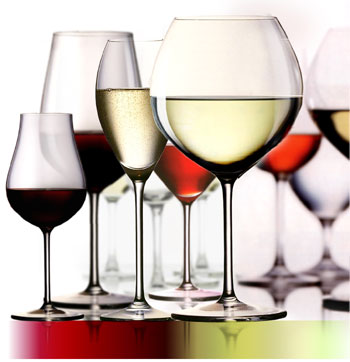 The importance of sight in the evaluation of wine must be moderated by an understanding of its limits. General rules can be applied to wine colour from which a rough indication of variety, probable age and presence or absence of certain faults can be conjectured - but these rules are by no means foolproof, even for the most experienced judge. In a masked vertical of Riesling wines, the same wines from different vintages will inevitably have a range of different colours, and normally one would expect the colour to deepen with age. But then, climate variations also affect depth of the colour, so in a very hot year one might expect riper, lower acid wines which would develop colour earlier than the same wine style, from the same vineyard, from a much cooler year. In another line up with mixed varietals, say, some cool and warm climate wine examples of Riesling, Sauvignon Blanc, unwooded Chardonnay and barrel fermented Chardonnay, the situation becomes impossible if the aim is to guess the wines on sight alone.
The importance of sight in the evaluation of wine must be moderated by an understanding of its limits. General rules can be applied to wine colour from which a rough indication of variety, probable age and presence or absence of certain faults can be conjectured - but these rules are by no means foolproof, even for the most experienced judge. In a masked vertical of Riesling wines, the same wines from different vintages will inevitably have a range of different colours, and normally one would expect the colour to deepen with age. But then, climate variations also affect depth of the colour, so in a very hot year one might expect riper, lower acid wines which would develop colour earlier than the same wine style, from the same vineyard, from a much cooler year. In another line up with mixed varietals, say, some cool and warm climate wine examples of Riesling, Sauvignon Blanc, unwooded Chardonnay and barrel fermented Chardonnay, the situation becomes impossible if the aim is to guess the wines on sight alone.
We are just as likely to be mislead by colour and appearance by the associations between colours and flavours that we form and retain. If we see the colour of a wine and taste it, we have an expectation of the same flavour the next time we see a similarly coloured wine. Morrot et al.(2001) demonstrated that red-coloured white wine was frequently identified as red wine by tasters.(1) Wine lovers also tend to associate depth of colour with intensity and concentration of flavour. These observations pose the first question of this chapter: "Does a wine's colour have any bearing on its flavour?" Winemaker, Peter Gago observes"In most cases colour brightness and depth can tell you a lot of what to expect in terms of flavour concentration. However as likely as this is the case it is not a rule. Some grape varieties have dark colour and not much fruit flavour. Conversely, some lighter coloured varieties like Pinot Noir can have a lot of flavour".Ongoing research into this subject is inconclusive, however, for red wines, there may be some justification for this association:"Assessed [red] wine quality is often directly correlated to colour density (Iland & Marquis 1993) and hue (the proportion of red "ionized" anthocyanins) [see below] (Bucelli & Gigliotti 1993; Somers & Evans, 1974). These factors indicate that wine is well made (at an appropriate pH, low in SO2 and at an adequate ethanol concentration) and probably highly flavoured." (2) The grounds supporting this observation are outlined below, and have to do with controlling compounds in red wine grapes that many Australian viticulturalists seem to have intuitively mastered before fully understanding the science.
To answer the second, more general question as to"What information can be determined from looking at wine?", in order to avoid over-generalisation, it is necessary examine the colours of red, white and fortified wine types separately. The colours of red wines are generally more reliable signifiers than those of whites, due to the fact that a large number of pigment related compounds are present which are often varietal-specific, a result of viniculture or even terroir related.
| Video: The colours of Dry Red Wine. |
The Colour of Dry Red Wine
The juice from all grape varieties is clear, even that coming from red skinned grapes.(There are a couple of red grape varieties that do have red juice - Jacquez, Souzao Alicante Bouchet and Gran Noir de la Calmette).The colour of red wine comes primarily from phenolic molecules which develop in the grape skin itself, not the pulp, although phenolic compounds are also found in grape seeds and stems. For many readers, we will have just used an unfamiliar term.What exactly are phenolics? Technically, they are a class of compounds containing a phenyl ring and varying substituents. For the laymen, phenols are found in many organisms, from animals to small microbes in which they function as defense mechanisms, as well as in various plants where they act as protection by stopping biologically active growth inhibitors. Since phenols are developed as a defense mechanism for plants, the more stressed the vines are, the more phenols the plants will produce. * Phenolics also form during a wines fermentation and maturation, but these are insignificant compared to the amount naturally present in grape skins.
The total amount of phenols found in a glass of red wine is of the order of 200 mg versus approximately 40 mg in a glass of white wine.(3) Apart from effecting a wines fragrance and astringency (especially in red wines), the presence of phenolics acts as a preserving agent, essential for a wine to age gracefully. Since phenolics also readily oxidize, they are the substance responsible for turning wine brown when exposed to air.
Accounting for red wine colour in any detail requires a sub division of phenolics into two groups: Non-flavonoids (hydroxycinnamates, hydroxybenzoates and the stilbenes); and Flavonoids (flavanols, catechins (flavon-3-ols) and in red wines, anthocyanins) which comprise more than 85% of the phenolic content in reds. Of particular significance are anthocyanins, being a large class of pigments among plants making the bright blue, violet, red and purple colours we see in fruits, vegetables and flowers. Blueberries, blackberries, raspberries and red grapes, for example, contain dozens of different anthocyanins. In grape berries, they exist within the cell of the outer layer of the skin, so in order to maximise a wines colour, the grapes must be crushed and pressed, and the juice left for extended skin contact during fermentation.
Just as humans differ in skin tone, phenol concentrations vary amongst grape varieties. Certain varietals naturally yield more anthocyanin, especially Shiraz, Durif and Cabernet Sauvignon, with Pinot Noir and Gamay sitting at the opposite end of the spectrum. The quantity and structure of anthocyanins also depends upon climate, terroir and viticultural techniques: Yield reduction and the timing of harvest are particularly important. Managing vine canopies by selectively removing foliage also exposes grapes to more sun light which in turn catalyzes pigment formation. Since only the grape's skin contains pigments, smaller berries with a higher ratio of skin to pulp yield deeper colours and extremely ripe grapes have more fragile cell walls making pigment extraction easier. Some of the phenolic compounds in grape skin can be rather harsh so a wine maker must take great care to press the fruit gently, and not to over extract the amount of juice from any one batch.
There are many methods of maximising colour extraction with dozens more variations. The traditional technique is to plunge the floating skins which rise to the top of the open vat fermenter. Twice a day, the winemaker stands precariously over the vat and with a stainless steel, or timber plunger, laboriously breaks up the re-surfaced cap, forcing the skins to re-mix with the fermenting grape juice. Other winemakers use a system of pumping by which the juice is drained from the bottom of the stainless steel vat and brought to the surface where it breaks up the cap of skins and percolates its way back down to the bottom. Another method utilizes header boards. The process has been traditionally carried out in open top concrete tanks, pushing the grape skins below the top of the juice, forcing the grape skins into contact with the juice. In most modern wineries, the heading down is carried out in stainless steel tanks, which have a central rise tube, allowing the fermenting juice to rise up under carbon dioxide pressure and flow under the skins, to extract the pigments. Still other producers favour rota fermentation, which involves large tanks similar to rotating tanks which can be seen on the back of concrete trucks. Inside, spiral flanges move the grape skins in the opposite direction of the rotation increasing juice contact and promoting colour extraction. (See the section on Making Wine for more detail on these procedures).
As one would expect from the scientific community, there remains a degree of debate as to the extent to which phenolics are responsible for red wine colour and research continues to reveal other mechanisms at play. A University of Navarre research team (2005) has demonstrated that hues varying from bluish red to an earthy orange, are influenced by - amongst other factors - the stability and reactivity of metals present in wine, such as iron, zinc, copper and manganese. A small quantity of iron in red wines, for example, produces an increase of between 8% and 30% of its blue component, with a consequent similar decrease in its percentage of red. (4)
| Video: Colour development in Dry White Wine. |
The Colour of Dry White Wines
Australian scientists from the national science agency have recently discovered that a pair of ancient mutations in the genes that give grapes their red colour gave rise to the first white varieties more than 3,000 years ago. An earlier Japanese study had already shown that one of those genes regulated red colour in the skins of fruit (such as apples) by switching on production of anthocyanin molecules. The new research identified a second gene involved in the colour regulation pathway that had mutations in white grape varieties. Both mutations, said Mandy Walker, a research scientist from the CSIRO Plant Industry laboratories in Adelaide, South Australia, are required to turn grapes white.
Although white wines can also be made from virtually any red grape variety,"If only one gene had been mutated, most grapes would still be red and we would not have the more than 3,000 white grapes cultivars available today".(5) Pinot Noir and Pinot Meunier are the classic red varietals that are used in the making of champagne and in the past some winemakers have experimented in making a white wine from Cabernet Sauvignon and Zinfandel. This process is simply achieved by the removal from skins from the juice or even by the filtration of red wine through a carbon filter, removing the red colour components, which usually leaves a slight pink tinge to the wine.
But compared to our knowledge of the sources of colour in red wine, the nature of colour in white wine is not very well understood. It is certain that white wines are generally low in phenolic compounds and do not age as well (this is largely due to the short time the juice is allowed to remain in contact with the grape skins). It would appear that non-flavanoids are the primary contributor to white wine colour and the many components believed to contribute to the colour of white wines includeQuercetin, Catachins and Chlorophyll.
Winemaking practices must also be taken into account. It is not uncommon for a new vintage white wine to be watery in colour, particularly if the wine has been fermented under controlled conditions in a neutral stainless steel vessel .The underlying assumption is that the wine has also been carefully protected from premature oxidisation, by carefully harvesting cool grapes with unbroken skins and little contact with air prior to fermentation. However, the same wine grapes fermented differently might start out by being pale straw in colour and gradually deepening with bottle age. A Chardonnay, for example, of the same year might appear pale gold in colour, and look prematurely aged for its years. This quality could be attributed to an oxidative wine making process, by which the wine has been allowed to make deliberate contact with air in order to gain more complexity at an early age, or from extended maturation in oak barrels.
Colour Reference Standards for Table Wines
Despite all of the variables involved, the colour of wine can tell us something, particularly in the context of other information. In order to establish a reference standard for describing colour in dry red and white wines, certain descriptors have been generally agreed upon by winemaker education institutions. These are the colours outlined in the following tables, and refer to the colours visible in the curved upper surface of the wine in the glass, which should normally be transparent. This is the thinnest layer of wine available for viewing in the glass and its colour may indicate varietal type, winemaking techniques and the age or aging potentials of the wine.
| Colour | Approximate Age |
| 1. Damask | 1-2 years old methode champenoise rose |
| 2. Damask / Apricot hue | 2-5 years old methode champenoise rose wines |
| 3. Salmon Pink | Literally the colour of smoked salmon used to describe Rosé that has had extended skin contact, e.g. Rose d'Anjou |
| 4. Light Red / Ruby Red | 1-3 year old wines from heavy crops which have had excessive irrigation |
| 5. Mid Red / Crimson | 1-10 years old |
| 6. Purple / Mauve | 1-5 years old Cool Climate Reds |
| 7. Dark Red | 5-10 years old |
| 8. Brick Red | Either young wines with high pH or 8-15 year old, developed wine. |
| 9. Brownish Red | 10-20 + years old |
| 10. Tawny | 10-20 + years old. Warm climate, high pH wines. |
| 11. Brown | 10-20 + years old. Passed. |
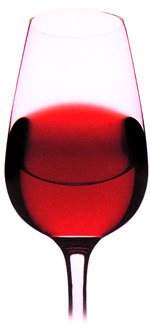 |
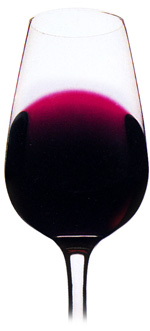 |
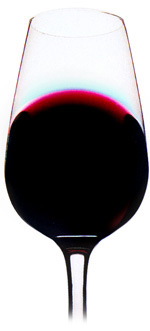 |
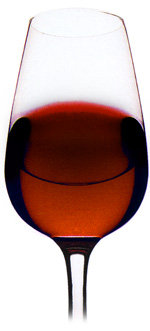 |
| 1. A very light and/or very young red wine with light extraction. | 2. A young, almost opaque red displaying a purple mauve hue, typical of many Australian Shiraz wines. |
3. A middle aged red wine, perhaps 4-5 years old, which is beginning to display some brick red colour. |
4. Aged red wine. The intensity of colours has diminished and the wine is taking on a brownish red appearance. |
Above: A general colour guide for red wines. Note: Colours may vary according to screen settings.
REASONABLE ASSESSMENTS FROM COLOURS OF DRY WHITE WINES
Note: The assumption behind the colour range is that the white wine was fermented in
temperature controlled stainless steal vats without the influence of any oxidative treatment.
| Colour | Approximate Age |
| 1. Water White | 1 year |
| 2. Pale Straw | 1-2 years |
| 3. Mid Straw | 2-3 years |
| 4. Deep Straw | 3-5 years |
| 5. Pale Gold | 5-10 years |
| 6. Mid Gold | 5-10 years |
| 7. Deep Gold | 5-10 years |
| 8. Orange | Passed* |
| 9. Light Amber | Passed* |
| 10. Mid Amber | Passed* |
| 12. Tawny | Passed* |
| 13. Brown | Passed* |
| 14. Sienna Brown | Passed* |
| 15. Green Olive | Found in some very old Sauternes |
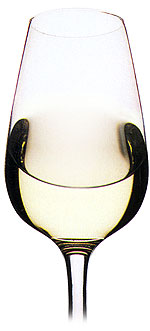 |
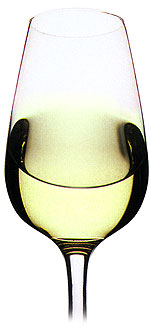 |
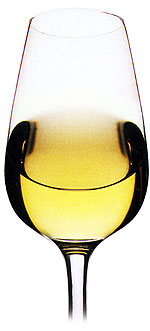 |
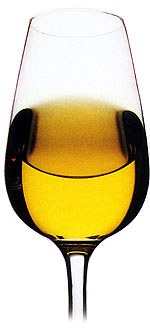 |
| 1. A very young white wine, pale straw in colour with subtle green tinges. |
2. A white wine with a deep straw colour, with green tinges suggestive of relative youth. | 3. Possibly a mature wine, or one that shows more extraction at any rate. |
4. An aged white wine, deep gold in colour, possibly passed its peak. |
Above: A general colour guide for white wines. Note: Colours may vary according to screen settings.
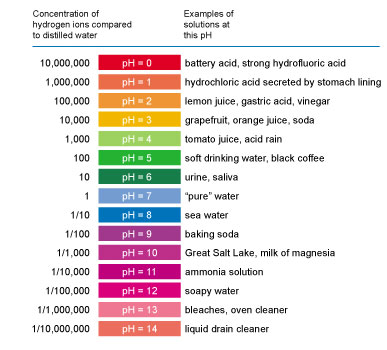 |
| Above: The pH scale. A substance that when added to water increases the concentration of hydrogen ions (lowers the pH) is called an acid. A substance that reduces the concentration of hydrogen ions (raises the pH) is called a base. Image source: The Pacific Institute for the Mathematical Sciences |
Colour in Youth as a Clue to a Wine's Future
For consumers, one the most unintelligible technical figures that might appear on a bottle's back label is "pH" (an acronym for 'potential hydrogen'). Essentially, pH is a term that quantifies the acidity of a solution. For us, it is describing the acidity of wine. One of the most important things to realize about pH is its seemingly backward association with acidity. The LOWER the pH, the HIGHER the acidity. For example, one of the strongest acids known to man, hydrochloric acid (the acid in your stomach), has a pH of 1. The presence of the right amount of total acidity in wine is indicated by richness of colour and influences a wine's aging potential. The upshot for the wine lover is that knowing the logic behind pH, helps forecast the cellaring potential of the wine on offer.
The acidity of a wine is critical in maintaining the colour in red wines. The normal range of pH in Australian wines is between 3.0 and 4.2. As acidity decreases, the anthocyanins lose their colour and may even turn blue. In addition, oxidation is inversely related to acidity. The less acidic, the higher the degree of oxidation a wine will undergo turning the colour brown.
pH VALUE 2.
At this level, the acidity of the wine would be very high, making the wine taste extremely tart. A purple colour would be evident at this level of pH.
pH VALUE 3.0 - 4.2.
This is the normal range of pH for Australian reds, although a pH reading in the high 3's would indicate that a wine would not live as long as one in the mid 3's. The colour would be crimson purple.
pH VALUE 5.
At this level, the red colours drop right out leaving a tawny brown appearance. The wine would have very little aroma, and no keeping potential. If the wine is still young, a brownish hue indicates the wine has either oxidised or being exposed to long term heat. A wine cellared at 14C might reach its peak in say 10 years. However, should that wine be stored in temperatures as high as 50C, that wine would show the same colour and flavour as a 10 year old wine in a matter of months.
pH VALUE 8.
At this level, the colour would have dropped right out of the wine and an olive green appearance emerge. A wine well past its peak for pouring down the sink.
pH Values of White Wine
pH VALUE 2.
The colour would be very light, green yellow and the wine would taste excessively acid and be too tart to drink.
pH VALUE 3.0 - 4.2.
The colour in these wines would be bright, pale straw, as this is the normal range of pH for white wines. Acidity would be perceived as crisp, but in balance to the fruit.
pH VALUE 5.
The colour would be very deep, approaching amber, the acidity falling away and the wine tasting flat.
pH VALUE 8.
The colour would be brown and the wine undrinkable.
After a little practice, and actually recording the pH value of the wines at tasting, one can quickly develop a mental colour map that can adequately determine the pH of a wine, and thus project its potential longevity.
Colour Characterisitics of Other Wine Styles
| Video: Colour development in Sweet White Wine |
SWEET WHITE WINES
Sweet whites which may vary from a pale straw to golden-brown colour are usually made from late picked grapes in which sugar levels have been concentrated via dehydration. (See Making Sauternes & Sticky Wines.) The deep colour of some of these wines can create the impression of great age, but can also be deceptive. So too can a pale light colour, which is common if fermentation occurs at controlled temperatures in stainless steel.
Botrytis Effected Wines
Botrytis affected white grapes are the basis of the world's great sweet wines, such as Sauternes, Trokenbeerenauslese or the Australian Botrytis affected Semillons, Sauvignon Blancs or a combination of both. The winemaker is under great pressure to keep the oxygen contact of the fermenting juice to a minimum, as the botrytis enzyme has an affinity for oxygen molecules which it takes up to produce a deep golden colour. Sauternes drinkers in the late 1970's witnessed particularly deep colours from the first growth Sauternes house, Château Guiraud. The wines had received heavy oxygen exposure during fermentation and were already in mid to deep gold colour upon release. However, with better wine making procedures, Guiraud's wines are now released with a pale gold colour that deepens with age only very gradually.
Late Harvested grapes that are not Botrytis effected
These grapes are simply picked at very high sugar levels and fermentation stopped prior to the conversion of all the sugars into alcohol. These wines could easily start life as pale straw, and thus would be difficult to detect in a line up from a dry white wine. Their detection is possible by swirling the glass and observing the increased viscosity due to high levels of glycerol (in the case of the botrysized late harvest wines, glycerol levels in excess of 20 g/L are not uncommon), or by sniffing the wine.
Late Harvested Grapes picked frozen
These are rare wines, traditionally botrytis affected and produced in Germany as 'Eiswien'. The grapes are frozen by a late snap of cold weather and picked and crushed frozen. The water component of the grape juice freezes at a higher temperature than the sugar juice, and consequently is removed first during pressing, leaving behind a concentrated grape juice. Canada seems to have specialised in the production of these sweet wines and they can start life with a gold colour and deepen with time. The same applies to the colour of a wine produced via cryo-extraction.
The colour range that is generally accepted for sweet wines is as follows:
| Colour | Approximate Age |
| 1. Pale Straw | 1-5 years |
| 2. Mid straw | 1-5 years |
| 3. Deep straw | 1-5 years |
| 4. Pale Gold | 3-5 years |
| 5. Mid Gold | 3-10 years |
| 6. Deep Gold | 5-10 years |
| 7. Orange Gold | 10-50 years |
| 8. Amber | 20-50 years |
"Brassy gold" is often applied to botrytis affected Chenin Blanc wines from Appelations of Bonnezeaux, Quarts de Chaume and Coteaux du Layon in the Loire Valley, France. These wines have a remarkable capacity to age in the bottle, sometimes for well over a century, with the wines of Moulin Touchais standing out as wonders of vinous immortality.
FORTIFIED WINES
Like sweet white wines, fortified wines possess a colour spectrum that is easily misinterpreted, since an old wine is capable of looking young, and a young wine can be made to look old. Generally, fortified wines undergo development, and hence colour change by extended barrel maturation under a solera system, as in the case of sherries and tawny ports, or by undergoing bottle maturation, as in Vintage Ports. (See Making Fortified Wines.)
The age of a fortified wine upon its release to the market can vary, from being relatively young, (ruby ports may only be 3 years old), or very old, (with some dating back centuries). A fresh bottling of Manzanilla or Flor sherry will look very pale, yet left on the shop shelves for a couple of years the colour deepens considerably to straw or even deep straw, and correspondingly, the nose flattens and the palate broadens. An old Muscat from Rutherglen in Victoria, Australia may have a range of colours varying from light amber to sienna brown and have a very distinctive green olive tinge on the meniscus indicating great age - 20, 30 or 60 years old. However, the same appearance can be achieved by the use of a process known as 'jeropega'. This is a reductive process commonly used in Madeira, whereby the young Muscat is carefully heated in a copper pot and the 'water' evaporated off, leaving the winemaker with a thick viscous dark green/black liquid. This reduction is then blended with a young Muscat which takes on a brown to sienna brown colour, with the classic green olive rim associated with extreme age. By looking at the two, one aged naturally and the other created on an artificially, you can't pick the difference. Smell the two examples and it's more than likely that you'll pick up a caramelised smell from the wine made using the jeropega process.
The generally accepted colour ranges for fortified wine is as follows:
| Colour | Approximate Age |
| 1. Pale Straw | Freshly bottled Manzanilla or Fino Sherry |
| 2. Mid Straw | Slightly older Manzanilla or Fino Sherry |
| 3. Deep Straw | As above |
| 4. Ruby Red | Young Port |
| 5. Crimson | Young Vintage Port |
| 6. Brick Red | Late Bottled Vintage Port |
| 7. Brownish Red | 10 Year Old Vintage Port |
| 8. Light Amber | 15 Year Old Tawny Port |
| 9. Deep Amber | 20+ Year Old Tawny Port |
| 10. Tawny / Onion Brown | 10-20 years old |
| 11. Brown | 20+ years old |
| 12. Sienna Brown | 20 - 200 years old |
| 13. Olive Green | 10+ years old (colour appears at edges) |
Visual Characteristics of Wine Unrelated to Colour
| Video: Lack of clarity in wine. |
1. Clarity
Clarity, lack of which nowadays is always considered a fault in young wines, is important in that it can provide insight into a wines condition and stage of development. Alternatively, a slight haze may indicate that a wine has been left unfiltered in order to maximise flavour, as is often the case with Pinot Noir. (The suspended particles settle down if the wine is left to stand in an unopened position for 48 hours prior to serving). However, consumers generally expect a completely clear appearance - there is a perception that whatever has caused the cloudiness will also have impaired the wine's overall quality, hence considerable effort is usually undertaken in the winery to produce a beverage that is stable in terms of clarity. In white wine, a haze may be due to protein deposits and indicates that the winemaker has not stabilized the wine properly. If a white wine has not been cold temperature stabilized, then it is more than likely that tartrate crystals will form. These may be present under the cork or in the bottom of the bottle. The crystals are harmless and appear like small pieces of broken glass.
The generally accepted descriptions for degrees of clarity are listed below.
1. BRILLIANT. This is the condition that is associated with many white wines, but can also refer to less opaque red wines; it refers to perfect transparency. Brilliant wines still may have some suspended particles (e.g. tartrate crystals) but they do not affect the wine's transparency as they tend to quickly subside.
2. CLEAR. Refers to perfect transparency and displays a complete absence of suspended particles.
3. CRYSTAL CLEAR. This refers to a wine of perfect transparency.This is a degree of clarity higher then clear.
4. SHADY. Cloudy wine, in which transparency and brilliance are slightly missing.
5. CLOUDY WINE. This condition is apparent due to particles of gel, protein etc in suspension.
6. MIRKY. This is the condition of a young wine prior to racking, and displays heavy cloudiness.
Alternatively, clarity has being defined by making a suspension of yeast cells in water.
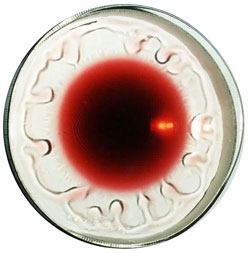 |
| Above: Looking down into a wine glass with tears clearly visible. Image source: www-math.mit.edu/ |
2. Legs, Tears & Cathedral Windows
When wine is swirled around in the glass, you may have often observed the accumulation of an oil-like ring or film of clear liquid appearing on the walls of the glass (see illustration). From this ring, liquid drops of the accumulated liquid will flow back down into the wine, forming so called 'Cathedral windows' or arches and leaving streaks, "legs" (or as the French say 'cuisses'), down the insides of the glass. These legs may be very noticeable or almost non-existent, either thick or thin and can vary in number. It is sometimes claimed incorrectly that the number and thickness of legs relates to a better quality wine, or that for example, heavy, slow legs indicate a wine high in glycerol. The thickness of the legs has also being thought to reflect upon the anticipated body and weight of the wine as well as its mouth-feel. In fact, legs form because of the alcohol content of the wine and the effects of surface tension, adhesion and evaporation. The alcohol, because it has a lower surface tension, tends to crawl up the glass. At the same time, alcohol evaporates from the film more rapidly than from the body of liquid in the bowl of the glass. As more alcohol evaporates from the glass walls, the water concentration increases and droplets begin to form. The greater surface tension of the water causes the wine to pull together and droplets start to sag producing 'arches'. Finally, the drops run down the inside of the glass forming 'tears'.
This action was first explained by James Thomson in an 1855 paper,"On certain curious Motions observable at the Surfaces of Wine and other Alcoholic Liquors". However it was later attributed to Carlo Marangoni based on work he did in the 1870s. It is referred to as the 'Marangoni' or 'Gibbs-Marangoni' Effect. You can test this theory easily enough: swirl a glass of wine and observe the formation of legs. Now cover the glass and swirl it again. In a few tries, the legs will usually stop forming. This is because the air inside the glass contains enough alcohol vapour to prevent more alcohol from evaporating and the formation of legs stops. Uncover the glass and legs will start to form again.
Legs may be an indicator of a wine's alcoholic strength because the higher the alcohol content, the faster the alcohol evaporates, but they are not a measure of a wine's viscosity (see below), nor do they have any bearing on the quality or the pedigree of the wine. Legs merely demonstrate that wine contains more water than alcohol, and alcohol evaporates faster than water.
3. A Note on Glycerol and Viscosity
Many wine commentators have traditionally associated the phenomena of 'tears' with high glycerol content in a dry table wines, coupled with the belief that glycerol contributes positively to wine quality in terms of mouth-feel and texture properties."In some instances, clear anomalies exist between the perceptions and actual data that have been obtained through experimental work. No positive relationship between glycerol per se and the mouth-feel attributes of wine has yet been established and several factors other than glycerol have been implicated in mouth-feel. These include the ethanol concentration, the yeast cell wall mannoproteins, barrel maturation, yeast autolysis, the yeast strain used, as well as phenolic compounds in red wines (Ribéreau-Gayon et al., 1998; Deltail & Jarry, 1992). Furthermore, at the concentrations at which glycerol is normally found in wine (typically at concentrations of 4 -10 g/L in dry wine), the impact that it could have on the viscosity of wine would probably not be perceived by even the most experienced tasters (Noble & Bursick, 1984). Against this background it is quite possible that the perceived contribution of glycerol to mouth-feel can easily be over-emphasized".(6)
4. Bubbles in Wine (Effervescence)
Chains of bubbles are certainly expected to be present in Champagne or Methode Champenoise. However, they can also make an unwanted appearance in wines that were intended to be still, both red and white. This is usually caused by wine being bottled before excess carbon dioxide has had time to escape, but may indicate a more significant problem, particularly in cool climate areas where an incomplete malolactic fermentation is at fault.
The size of bubbles in a sparkling wine can also give us some clues as to what process was used in its production. Top champagne or sparkling wine made according the methode champenoise process has very fine bead (bubbles) which rise in a steady, continuous stream vertically up the glass. Sparkling wine made by the transfer method, Charmat process or by simple carbonation will have a larger (coarser) and less persistent bead. An old sparkling wine may lose a lot of its bead, or offer a very slow but fine bead - most likely due to the shrinkage or inelasticity of the cork which has caused a slow escape of dissolved carbon dioxide from the bottle.
When serving very old sparkling/champagne wines, preparation is important in order to maximise bubble retention. Chill the wine longer and slightly colder than the usual ( 10 C). Serve in flutes which have been left in the freezer for a short time. The combined result will be that the bubbles in the old champagne last a little longer. ***
The accepted definitions of bubbles in wine are defined as follows.
2. BEADY. This refers to the presence of unfinished malolactic fermentation or even worse still, the tail end of alcoholic fermentation. Sometimes still evident in cool climate wines from cavalier producers.
3. PETILLANT or SLIGHTLY SPARKLING. The pressure of these wines varies from 2-3 atmospheres. Carbon dioxide gas is present in the form of fine, but relatively few bubbles, which rise to the surface to create a slight covering of froth. These wines can sometimes be referred to as 'Spritzig' or 'Frizante'.
4. CREMANT. This refers to a slight sparkle and is found in sparkling wines which have a pressure equal to 3.5 atmospheres.
5. MOUSSEAUX or FULLY SPARKLING. The pressure of carbon dioxide gas in the wine is between 4-5 atmospheres. The bubbles that rise to the surface of the wine are generally fine and persistent (a determinant of quality in sparkling wine). The bubbles leave a thin froth over the surface of the wine and then radiate from the centre to the edges of the glass where they form a collar.

1. The Effect of Visual Images on Perception of Odors. Nobuyuki Sakai, Sumio Imada, Sachiko Saito, Tatsu Kobayakawa and Yuichi Deguchi. Chemical Senses vol. 30 suppl 1 Oxford University Press 2005. Sakai (2004) also found that almost all participants correctly identified a cola-flavored solution when it was colored dark brown, but that many participants misidentified cola-flavored solution as orange or tea flavor when it was colored orange.
2. Wine Science: Principles, Practice, Perception. By Ron S. Jackson. Academic Press, 2000.
3. Wine Phenolics. Andrew L. Waterhouse. Annals of the New York Academy of Sciences, 2002. Department of Viticulture and Enology, University of California, Davis, California
4. Research Finds Relationship between Wine Colour and Metal Content, November 22nd, 2005 News report from http://www.azom.com
5. White wine a 3,000-year-old mutant. By Sarah Bartlett, Cosmos Magazine Online. Wednesday, 7 March 2007
6. Christin Carlson, 2004 from Andrew L. Waterhouse, Department of Viticulture & Enology, University of California Davis, California
* The positive effects of controlled vine stress on wine colour are consistently demonstrated by the extraordinary colours achieved in red wines from the drought stricken Heathcote region in Central Victoria, Australia. The Shiraz wines grown on its rare 500,000,000 year old Cambrian soil in particular, bestow a colour that is a complete saturate of black / purple, seemingly unique to the region and indicative of the intense flavour profiles that follow.
** Some technical information adapted from Cal Wineries
*** Some restaurants, which inevitably use dishwashers to wash their glasses, find that even fine champagne loses its bead rather quickly due to the fact that the glasses are simply too clean. To encourage maximum bead, a cross is often etched on the bottom of the glass to form the springing point from where the bubbles emerge.
